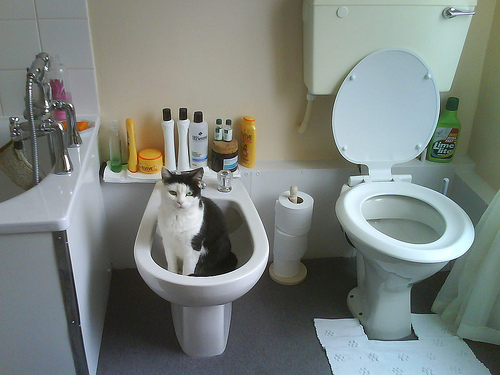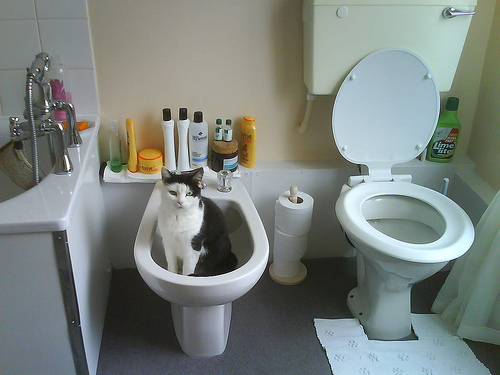Send your question to Umbra!
Q. Dear Umbra,
We’ve been using “pee rags” for a while now, but are trying to find a way to do away with toilet paper all together. The obvious option is washing, but is the impact of water use for washing close to or equal to the small amount of toilet paper we’d be using for the times when we need something more?
Jessie
Kittery, ME
A. Dearest Jessie,

Toilet paper? Pee rags? Bidets? You can probably tell where this cat’s loyalties lie. (Photo by Patrick van IJzendoorn.)
Well, I’m flushed! The toilet tissue issue surfaces yet again. And for good reason. Squeezing the Charmin does some harmin’.
In past columns I’ve addressed the impact of flushing toilet paper, and the glory of using recycled toilet paper (note: recycled toilet paper is not actually recycled from other toilet paper.) But your question opens up new toilet paper territory, Jessie.
Let me first say that I admire your inventiveness but I wish you would come up with another name for “pee rags.” I’m assuming they are to toilet paper what the cloth napkin is to the paper napkin. I’ve also heard this called the “family cloth”, an unfortunate misnomer, since the “cloth,” hopefully, is not shared.
For the uninitiated, this method involves placing a stack of clean cloth strips by the toilet. Use one, toss it in a bucket with a lid, then throw them in the wash at least once a week and voila! No more toilet paper.
Although, many people who use this method, do keep a few recycled rolls handy for guests. It’s prudent to “have a square to spare.”
Here’s a Grist staff review of recycled toilet-paper brands.
Now, to get to the heart of your question, Jessie. A lifecycle analysis of toilet paper, which takes into account all the water, energy, trees, chemicals, and bleach used to make toilet paper, shows that making TP certainly uses more water than doing a load of laundry. So you can stop hitting your head about hitting the head.
What’s more, according to the Natural Resources Defense Council, it takes more water to make toilet paper than it takes to make recycled paper. Treehugger says it takes approximately 37 gallons for the average roll. By contrast, your average full-size, front-loading Energy Star washing machine uses only 20 to 25 gallons. And chances are you’ll be washing other things at the same time, making the number of gallons used for what I’ll call “reusable toilet wipes” even lower.
Your method, Jessie, not only saves precious resources, it also saves you money! Because when you buy toilet paper, you indirectly throw money down the toilet.
Of course, a way to conserve even more — and not leave any paper trail — is to use a bidet. Both pragmatic and good for hygiene, bidet-use is less resource intensive than toilet paper. For those unfamiliar with the bidet, it is a sink-like fixture often situated next to a toilet. You can even get a bidet attachment for your current toilet.
The only problem with the bidet is that it’s hard to bidet someone’s home on Halloween. Also, you can’t steal a bidet from work or a hotel. And they are wet. So you’ll have to get used to the feel of a refreshing spritz. And, of course, you’ll want to dry off. Some bidets have a dryer built in. If the bidet you’re using doesn’t, simply use a cloth towel.
If you get a bidet, perhaps this SNL sketch will make a lot more sense to you.
[vodpod id=Video.16192810&w=525&h=325&fv=]
Another way to lower your toilet paper footprint is to pee in the shower. As long as you’re multitasking with the water on, why not? Learn more about it in my video.
Ask Umbra’s Video Advice on Saving Money (and water) in the Toilet
[vodpod id=Video.16192947&w=615&h=375&fv=%26rel%3D0%26border%3D0%26]
So there you have it, Jessie! Getting straight to the matter. Fecal matter, that is.
Ok, seriously. I’ve had enough toilet humor!
Skip to my loo,
Umbra


